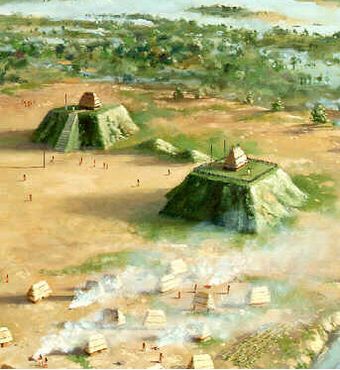Shiloh Indian Mounds Site facts for kids
|
Shiloh Indian Mounds National Historic Landmark
40 HR 7 |
|

How the Shiloh Indian Mounds Site might have looked
|
|
| Location | Hardin County, Tennessee |
|---|---|
| Nearest city | Savannah, Tennessee |
| Area | 81 acres (33 ha) |
| Architect | Mississippian culture |
| Architectural style | Mounds |
| NRHP reference No. | 79000279 |
Quick facts for kids Significant dates |
|
| Added to NRHP | April 27, 1979 |
| Designated NHL | May 5, 1989 |
The Shiloh Indian Mounds Site (also known as 40HR7) is an ancient place where people of the Mississippian culture once lived. It is an archaeological site, which means it's a place where scientists study the past through things left behind. This site is found next to the Tennessee River in Hardin County, Tennessee. It is part of the Shiloh National Military Park.
This special site is a National Historic Landmark. It is one of the biggest ancient villages from the Woodland period in the southeastern United States.
Contents
History of the Shiloh Mounds
People first lived at the Shiloh Mounds around the year 1000 CE (which means Common Era, like AD). These were Native American people from the Late Woodland period. Later, people from the Early Mississippian culture lived there. The village was left empty around 1350 CE.
The Ancient Village
The Shiloh Indian Mounds National Historic Landmark is on a high cliff. It sits between two deep ditches, looking over the Tennessee River. The village was protected by a tall wooden fence, called a palisade.
Inside the fence, there were more than 100 houses. These houses were made from wattle and daub. This is a building method where walls are made of woven branches covered with clay. There were also over three dozen smaller mounds where individual houses stood.
The site had eight large mounds. Seven of these were flat-topped mounds, called platform mounds. People built important buildings or homes for leaders on top of these. The eighth mound was a round, cone-shaped mound from the Woodland period. This was a burial mound where important people were buried.
Shiloh was the largest village in its area. It was likely the center of a large group of villages led by a powerful chief. This chiefdom controlled about 20 miles (32 km) of the Tennessee River Valley. Six smaller villages, each with one or two mounds, were part of this chiefdom. Many small farms were also scattered along the valley. The southernmost mound at Shiloh was a burial place for leaders and other important people. It was oval-shaped with a round top.
Food and Farming
The people of Shiloh Mounds were very good at farming. They grew a lot of maize (corn). They also grew other important crops that came from the Americas. These included squash, sunflowers, goosefoot, marshelder, and maygrass.
Besides farming, they also collected wild foods. These included acorns and hickory nuts. Hunting was also very important for their food. They hunted animals like whitetail deer, squirrel, rabbit, turkey, and raccoon. Fishing in the river was another key way they got food.
Neighbors and Connections
The Shiloh chiefdom included the main Shiloh site and six smaller towns. Each of these smaller towns had one or two mounds. An example is the Swallow Bluff Island Mounds site. There were also many small farms spread out on higher ground in the river valley.
Downstream from Shiloh, near where Savannah, Tennessee is today, there was another large village with a wooden fence and many mounds. Scientists are not sure if both villages were lived in at the same time.
Other groups of people lived along the Tennessee and Tombigbee Rivers. Their villages were in Alabama, Mississippi, and western Tennessee. Archaeologists believe the people of Shiloh Mounds had strong ties to the Cahokia site in Illinois. This is because special items from Cahokia have been found at Shiloh. This suggests they were more connected to Cahokia than to other chiefdoms closer by.
Studying the Past: Archaeology
The Shiloh site has been part of the Shiloh National Military Park for a long time. This means it has not been disturbed by modern farming methods. Because of this, you can still see the remains of the original wattle and daub houses. They look like low rings or small mounds on the ground. This is rare in the eastern U.S.
The site was added to the National Register of Historic Places in 1979. It was then named a National Historic Landmark in 1986.
Digging Up History
The first archaeological digs at Shiloh happened in 1899. Cornelius Cadle, who was in charge of the Shiloh Park Commission, led this work. He had a trench dug into Mound C, which was the cone-shaped burial mound.
During these digs, they found a large stone pipe. It was carved to look like a kneeling man. This pipe is now the most famous item found at the site. You can see it on display in the Tennessee River Museum in Savannah. The pipe is made from a special material called Missouri flint clay. It is carved in the same style as other statues found at the Cahokia site in Collinsville, Illinois.
More survey work was done at the site in the winter of 1933-34. During this time, many house mounds were found. These mounds were about 10 to 20 feet (3 to 6 meters) across. Many of them contained the remains of wattle and daub houses. It was also at this time that the large wooden fence (palisade) around the village was discovered.







